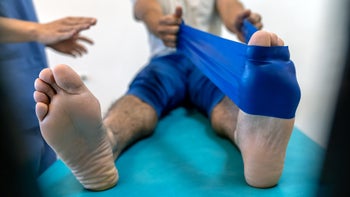
6 Ways to Successfully Treat Sciatica at Home
Key takeaways:
Sciatica is a condition marked by back and leg pain due to irritation of the sciatic nerve.
A healthy and active lifestyle can help prevent the risk of sciatica. But once it starts, several options are available to treat sciatica.
Most people with sciatica get better with self-care over time.
Table of contents

If you’ve ever had sciatica, you know how uncomfortable it can be. And you’re not alone. Many people have experienced pain shooting down their leg from their back. You may have even had numbness or tingling down your leg or a bit of leg weakness. These are all signs of sciatic nerve irritation.
Sciatica is pain along the sciatic nerve — the largest nerve in your body. It travels down the back of your leg and is formed from four nerve roots. Sciatica occurs due to inflammation of the sciatic nerve. This can happen anywhere along the nerve or in one of its nerve roots. In fact, a herniated disc, muscle spasm, or inflammation may pinch a nerve root in your back and also cause sciatica.
Fortunately, sciatica can be treated at home in most cases. And many times, it will resolve on its own. Let’s take a closer look at the six steps you can take to treat and manage sciatica pain without having to leave the comfort of your home.
Search and compare options
1. Staying active
Contrary to popular belief, bed rest isn’t recommended for sciatica. In fact, low impact exercise — such as walking — is good for sciatica. And for even less impact, exercising in the pool may be tolerated better when you have severe pain.
It may take several months to get relief. But once your pain resolves, it’s important to continue doing low-impact exercise over the long term. This helps to avoid any recurrence and keeps your muscles and spine in good condition.
2. Gentle stretching and range of motion exercise
Gentle stretching and flexibility exercises can improve sciatica pain over time. Spine exercises work by stabilizing the spine and improving core strength and flexibility. Stretching the piriformis muscle may help release the tension on the sciatic nerve. Focused stretching of the hamstrings muscles may also help.
Back and hip stretches shouldn’t cause you further pain or discomfort. If you’re not sure which stretches are safe, talk to your primary care provider or a physical therapist. They can give you guidance so your exercises are more effective and safe.
3. Heating pads or cold packs
Heating pads or cold packs can help to decrease pain, muscle spasms, inflammation, and stiffness. Cold packs can be applied for 20 minutes to the area of pain. But make sure you don’t apply it directly to your skin. It’s best when wrapped in a towel to avoid burns. Cold can be used for acute pain in the first 48 to 72 hours. Heating pads can be used for more chronic pain lasting more than several weeks.
Talk to a healthcare professional to find out whether heat or cold is best for you. Some people with underlying medical conditions may be extra sensitive to heat or cold therapy, including those with:
Infection
Open wounds
Cancer
Peripheral vascular disease
4. Avoid prolonged sitting or standing
Avoiding activities or movements that worsen the pain, such as sitting or standing for too long, can help treat sciatica. If you must sit for long periods, place a small pillow behind your lower back. This will help give you extra support. If you must stand for a long period, try alternating resting one of your feet on a stool to relieve some pressure.
When dealing with sciatica, it’s also a good idea to avoid wearing and standing in high heels. Flat shoes with good support are best.
5. Proper posture
Sitting in awkward postures increases the risk of back pain and sciatica. Sitting slouched for long periods or in postures that increase or decrease your normal spine curvature may put too much pressure on your spine.
You can improve your posture by:
Sitting with both feet touching the floor (not crossing your legs)
Sitting tall with your chest open so your shoulders aren’t rounded
Keeping your elbows close to your body
Making sure that your back, hips, and thighs are fully supported
If you’ll be sitting for long periods, switch positions often and take breaks for brief walks and to do gentle stretches.
6. Not smoking
Smoking can lead to low back pain and sciatica. Smoking can have many effects on your body that make you more likely to have sciatica, like:
Reducing blood supply
Promoting inflammation
Interfering with healing and repair
Causing degeneration of the discs in the spine
If you or someone you love needs support quitting tobacco, call 1-800-QUIT-NOW (1-800-784-8669) for free coaching, educational materials, referrals to local resources, and more. You can also talk to a healthcare professional for counseling or medication that can help.
How to get immediate relief for sciatica pain
Sciatica may improve by itself in a few weeks, although it may take several months for total relief. In the meantime, you can try a few things for fast relief. Keep in mind they’re only temporary, and there are no quick fixes for sciatica. These treatment options include:
Over-the-counter (OTC) pain relievers (like ibuprofen or naproxen)
Cold packs (to relieve pain and reduce inflammation)
Heat packs (to improve blood flow and muscle tightness)
Exercise (to relieve stiffness)
Spinal injections (to relieve pain and inflammation)
When should you go to a healthcare professional for sciatica pain?
In many cases, sciatica can be managed on your own at home. But you should seek medical attention for sciatica if:
Your sciatica pain doesn’t improve in a few weeks
You have difficulty doing your daily activities
You’re having leg weakness or difficulty walking
You can’t control your bowel or bladder function
Do you ever fully recover from sciatica?
Yes, some people fully recover from sciatica. Sciatica pain tends to decrease gradually over time. And many people improve in 4 to 6 weeks even without treatment. About half of people improve within a year. If you have more severe symptoms, weakness, or need surgery, recovery may take longer.
Some people may have chronic pain and continue to need treatment over the long term. At least one-third of people with sciatica develop pain that persists a year or longer. But it’s difficult to predict who will have persistent pain. Some studies suggest that certain risk factors may increase your chances of having chronic or recurrent sciatica. These include:
Carrying heavy loads at work
Driving 2 hours or more daily
Having depression
The bottom line
Sciatica can cause bothersome pain and discomfort down your leg and in your back. Fortunately, with time, sciatica pain usually improves. But in the meantime, you can take measures such as staying active and doing stretching exercises to manage sciatica pain successfully at home.
Why trust our experts?


References
Ahmad Siraj, S., et al. (2022). Physiotherapy for piriformis syndrome using sciatic nerve mobilization and piriformis release. Cureus.
Centers for Disease Control and Prevention. (2023). How to quit.
Davis, D., et al. (2024). Sciatica. StatPearls.
Konstantinou, K., et al. (2018). Prognosis of sciatica and back-related leg pain in primary care: The ATLAS cohort. The Spine Journal.
Lis, A. M., et al. (2007). Association between sitting and occupational LBP. European Spine Journal.
MedlinePlus. (2017). Guide to good posture.
MedlinePlus. (2022). Taking care of your back at home.
OrthoInfo. (2022). Spine rehabilitation exercises.
Petrofsky, J. S., et al. (2015). Cold vs. heat after exercise-is there a clear winner for muscle soreness. Journal of Strength and Conditioning Research.
Qiu, Y., et al. (2024). Causal association of leisure sedentary behavior and cervical spondylosis, sciatica, intervertebral disk disorders, and low back pain: A Mendelian randomization study. Frontiers in Public Health.
Schmid, A. B., et al. (2023). Factors predicting the transition from acute to persistent pain in people with ‘sciatica’: The FORECAST longitudinal prognostic factor cohort study protocol. BMJ Open.
Seidel, B. J., et al. (2021). Therapeutic modalities. PM&R Knowledge NOW.
Tubach, F., et al. (2004). Natural history and prognostic indicators of sciatica. Journal of Clinical Epidemiology.

























